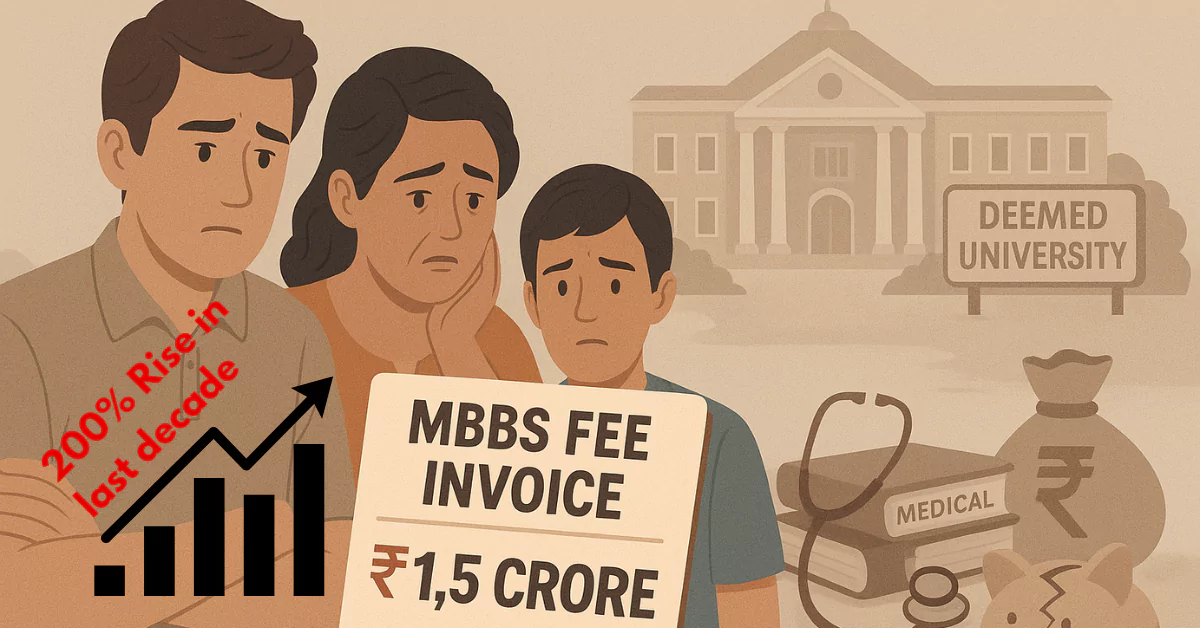Deemed University MBBS Fees: Deemed universities has more autonomy than self-financing or government medical colleges. This allows them to set MBBS tuition fees freely, without oversight from state medical fee regulatory bodies.
Since 2015, tuition fees at several deemed MBBS universities have surged by nearly 200%, reaching as high as ₹1.5 crore for the full course, or ₹30.5 lakh per year.
Financial Impact on Parents and Students
Such steep hikes are pushing medical education financially out of reach for many middle-income families. Experts warn that this level of cost could significantly reduce access to medicine careers, which were once a stable path for many.
Many parents look for educational loans, going with savings, or even selling property to afford these costs, even though starting salaries for fresh MBBS grads typically remain under ₹40,000/month, creating a long-term burden.
Deemed Universities vs. Self-Financed Colleges
- Self-financing colleges, unlike deemed universities, fall under state fee-fixing bodies.
- Those committees limit tuition but do not control add-on charges, like hostel, insurance, and development fees, which can add another ₹3 lakh/year.
- Meanwhile, deemed Universities bundle such additional costs directly in their high tuition packages without transparency, a significant cause for concern among parents and educators.
What Parents & Experts Are Saying
Parents and student counsellors demand clear fee structure during counselling and admission; many reports find huge hidden expenses only at college reporting time.
Both the state and national medical associations are urging increased oversight. They contend that unchecked price hikes will widen opportunity gaps and restrict medical education to affluent families.
Legal & Regulatory Landscape
Efforts by the UGC and judiciary to cap such fees have not been successful.
In 2019, the UGC proposed mandatory fee committees for deemed universities, including penalties for non-compliance, but the proposal remains unimplemented to date.
Supreme Court rulings such as Mohini Jain v. State of Karnataka (1992) reaffirm that excessive fees undermine the constitutional Right to Education under Article 21.
Why Deemed University MBBS Fees Are Rising?
- Competition among deemed universities to enhance research, technology, and branding has led to escalating tuition.
- A global academic trend shows competition actually fuels price inflation, rather than reducing it.
- With no cap on deemed university fees, many institutes justify high charges by claiming high operating costs and investment in infrastructure, even if lab or hostel charges remain unregulated.
Deemed University MBBS Cost Breakdown (Estimated)
| Component | Estimated Annual Fee |
|---|---|
| Tuition | ₹30 lakh – ₹30.5 lakh |
| Lab & Clinical Charges | Included or extra |
| Hostel & Amenities | Up to ₹3 lakh |
| Total for 5-year MBBS | ₹1.5 crore or more |
List of 10 Costliest MBBS University in India
These top universities have crossed the ₹1 crore mark for 4.5-year MBBS course, with Sree Balaji Medical College leading as the highest at ₹30.5 LPA.
Note: NRI quota seats in these universities can cost ₹2–3 crore, but SBMCH charges ₹1.6 crore even for general quota management seats.
Impact of High Fees of Deemed Universtites
- Access Inequality: Many deserving students, especially from rural or lower-income backgrounds, may forego medical education entirely due to cost barriers.
- Oversupply Debate: Despite rising doctor numbers, experts cite an oversaturated market, e.g., Tamil Nadu already has 1 doctor per 600 people vs. WHO’s 1:1,000 ratio, calling for checks before expanding educational access further.
- Talent Distribution: When costs exceed earning potentials, graduates often rely on loans and may opt out of PG studies or public healthcare roles.
What Needs to Be Done?
- Regulate Deemed Institutions: Implement UGC’s proposed fee committee and enforce compliance through penalties.
- Transparent Cost Disclosure: Mandate full fee breakdown, including tuition and ancillary charges, on official counselling portals, similar to Tamil Nadu’s upcoming policy changes.
- Empower Regulatory Bodies: UGC, NMC, and ED must collaborate to ensure educational equity and prevent capitation or hidden fees.
The 200% rise in MBBS costs at deemed universities highlights a larger systemic challenge. Without regulation, transparency, and accountability, medical education increasingly becomes a privilege rather than a merit-based opportunity, limiting India’s ability to nurture doctors from diverse backgrounds.

